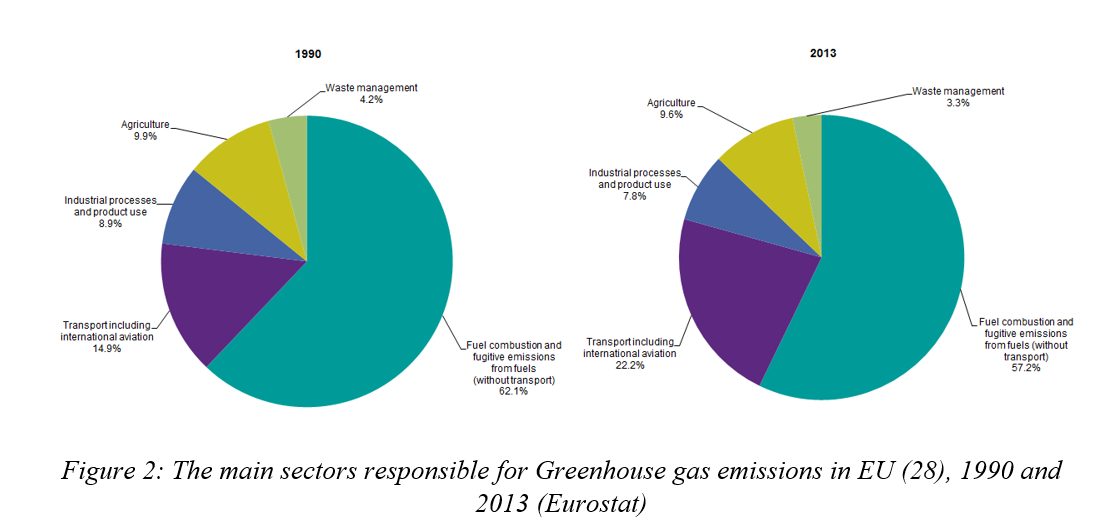- Home
- EF Databases
- How to build your own database?
- The Clim’Foot project methodology
The Clim’Foot project methodology
Priority sectors and categories considered
It has been decided that the Clim’Foot EF databases will consider these sectors because they represent the main issues in Europe:
- energy (fuel combustion and fugitive emissions from fuels);
- transport;
- industrial processes and product use;
- Metals
- Chemicals
- Minerals
- Pulp and paper
- Semiconductor productions
- Refrigerants
- agriculture
- waste management;
- land use, land use change and forestry (LULUCF).
For each sector, the hierarchical classification of processes considering three levels:
For example: if we consider the transport sector (main category), we have two kind of transports freight and passenger (first subcategory). Among the freight, there are several ways: air, road, rail, sea/rivers (second subcategory).
The Clim’Foot methodology is clear, agencies and institutes seeking to produce emission factors need to find data and invest time. The use of analyse cycle bases to feed their database is a first step.
Selection and analysis of existing databases
In the project the main reference for the methodology to develop the national databases is the IPCCs, that define the methodology to calculate GHG emission factors for the sector of energy, waste, agriculture, industrial process and product use. It is an important and reliable reference as it is developed at international level.
The national databases are key sources particularly for scope 1 emissions as they they are build on national context.
All databases shall be analysed regarding 2 points:
-
technical point: allowing to check the methodology for emission factors calculation, the economic sectors,etc.
-
management and government point: access to data, data review, contribution to data development,etc.
Recognition of potential sources of data for emission factor and their calculation
Usually, the number of EF included in a database is limited, and their value is often outdated or not representative of the activities you are interested by. In this case, you can look for a better EF in other databases: you should not use only one source !
Evaluation of use condition for existing emission factor
Some existing data are not free of charge (especially data from life cycle inventory database). Sometimes the emission factors havea been calculated using input data not free of charge.
Methodological issues
In the construction of national databases, some methodological issues on CF should be highlighted : LULUCF and biogenic carbon. There are not only one solution: the approach decided for Clim’Foot is presented in the methodology document for constituting the national database.
Database content
A data set has to describe and quantify activity in terms of emission factor. The activity can be referred to process/good/service and it is important to determine the reference flow of each activity, i.e. the measure of the process/good/service output taken into account for each dataset. You will find in a data set metadata, elementary flows and characterized GHG emissions.
- Metadata:
They provide a description of the data set with the aim to guaranty clear information to support the end user choices of dataset. The documentation intends to support a transparent reporting, interpretation and review of data collection, data calculation, data quality and data reporting, uncertainties, as well as facilitating data exchange. You can find some guidance about metadata in the ISO 14048.
-
Elementary flows:
The Clim’Foot database includes the GHG covered by the Kyoto Protocol. (link to the table 1). Each GHG is reported in the dataset in the quantity related to the functional unit in terms of kg.
-
Characterized GHG in CO2eq:
All emitted GHG are multiplied by their Global Warming Potential (GWP). The biogenic carbon dioxide (CO2b) is always accounted separately.
The details on how to constitute datasets for energy and transport sectors from different data sources are developed in the guide “Methodology for constituting the national databases”, chapter 6 and 7.
Data Quality Management Plan
A data quality management plan (DQMP) is a combination of procedures to properly manage data and their quality, to increase the robustness of the calculated EFs, both between the project partners (and managers of the database) and between the users of the CFO calculation tool.
Main objectives of a DQMP:
- Providing routine and consistent checks to ensure data integrity, correctness, and completeness;
- Identifying and addressing errors and omissions;
- Documenting and archiving inventory material and recording all quality-related activities.
In order to assess data quality, you have to build on requirements available on standard reference: GHG Protocol quantitative inventory uncertainty , ISO 14064-1 and PAS 2050 guidance. For LCA field, data quality assessment have been developed in ISO 14044, PEF/OEF and LCI databases own systems.
In order to develop a data quality assessment suitable to be used in the framework of the Clim’Foot project, a scoring system has been developed and displayed in the CFO calculation tool and favor the transition towards Ef databases.
The DQMP of the Clim’Foot project is in two parts:
-
Procedures to enable the publication of the emission factors from the identification of the data sources to the calculation and validation of data. Defining and setting up procedures consist on several steps illustrated on the figure below.
-
Rules for defining and calculating the quality of the emission factors.
EF publication process
A semi-quantitative assessment of the overall emission factors shall be calculated summing up the achieved quality rating for each of the quality criteria, divided by the total number of criteria. The Data Quality Rating (DQR) result is used to identify the corresponding quality level (cf methodology for constituting national database, ENEA).
DQR = (TiR+TeR+GeR+U)/4
Return to menu.

